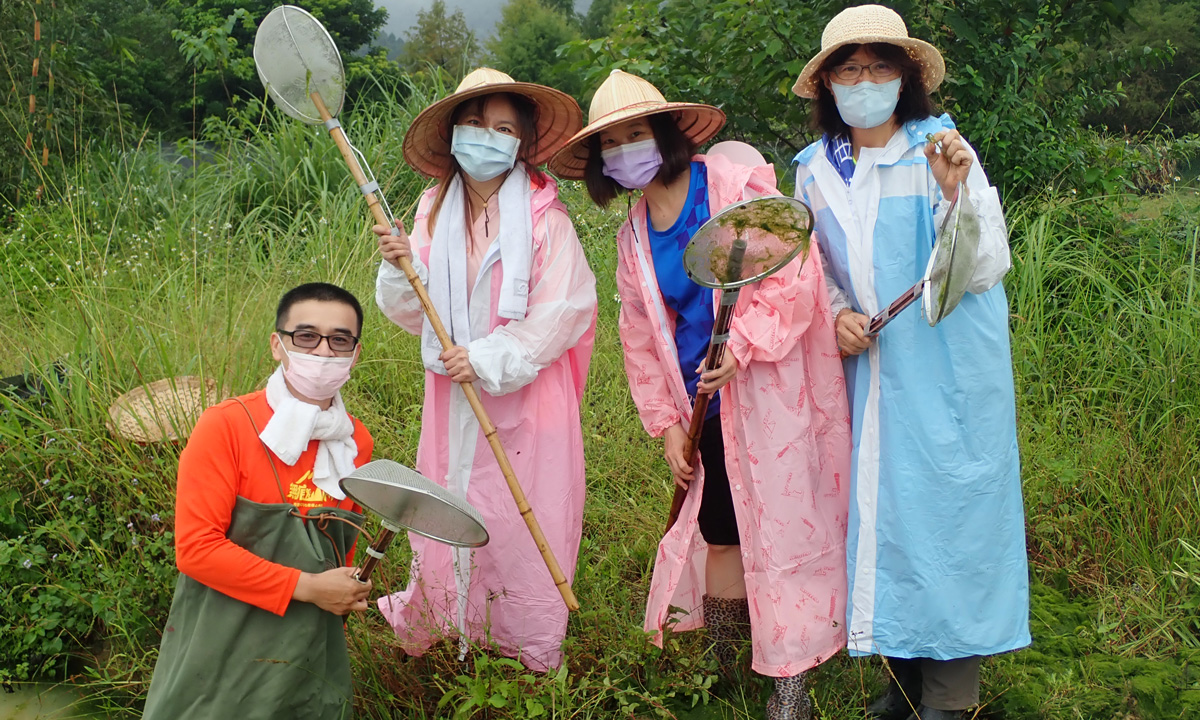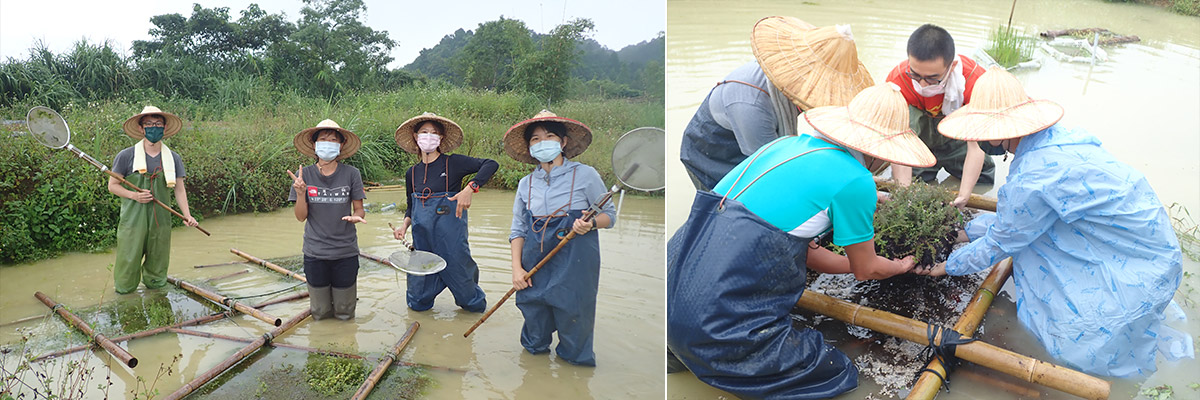
Shuanglianpi, located in Hushi Village, Yuanshan Township in Yilan County, is surrounded by mountains and filled with tranquility and beauty. The area is around 470 meters above sea level, and it is a low-altitude, in-land wetland. Shuanglianpi has been named a major national wetland and animal sanctuary. On October 16, more than a dozen IC Broadcasting’s volunteers woke before dawn to travel to Shuanglianpi. Originally, there were many aquatic plants in the Shuanglianpi lake. According to the surveys, there were up to 112 different species of aquatic plants in Shuanglianpi, accounting for more than one third of the endemic aquatic plants in Taiwan. However, around the year 2000, Shuanglianpi faced a development crisis. The owner of the land used excavators to clear the floating islands and sprayed herbicide on the sides of the lake. The owner filled the lakes with large amounts of grass carp and silver carp, gradually damaging the entire ecosystem. Subsequently, the Yilan County Government began reclaiming Shuanglianpi and established a wildlife protection area to solve the crisis. At the same time, the Society of Wilderness created the Shuanglianpi Eco Classroom, using it as a base for environmental education promoting the conservation of habitats in Shuanglianpi. As a result, many volunteers travel to the area every month to help with habitat maintenance and species restoration projects.
Since most of the participants are first-time environmental volunteers and first-time visitors of Shuanglianpi, they are given a presentation by the habitat protection specialist Shih Pei-Chun after arriving at the Shuanglianpi Eco Classroom, with a detailed introduction of the history of Shuanlianpi and which precious species live in the area. Why is the Society of Wilderness conducting habitat restoration in the area? After the presentation, the volunteers travel to the nearby species preservation pond with their shovels to prepare for the first task: slope restoration of the species preservation ponds.
Director Huang Zhen-Fu (A-fu) of the Shuanglianpi Eco Classroom said that slope restoration is, in simple terms, creating a gentler slope on the banks of the lake to restore the natural gentle gradient of a lake from the steep sides. This is because the smaller the angle of the incline, the more suitable the area is for aquatic plant growth. Submerged plants, floating-leaved plants, and emergent plants can all find waters suitable for their growth. Before the working holiday in October Yilan experienced heavy rains for several days. The water levels in Shuanglianpi rose, stopping work on the lakeshore. Therefore, the volunteer activities moved to the species preservation pond to improve the angle of incline on the shores of the preservation pond.
When they arrived at the preservation pond, the volunteers followed the instructions and dispersed to the shores of the three preservation ponds. They began to loosen and dig up the soil along the shore with their shovels and shoveling the soil into the pond. Many of the participants in their twenties or thirties that grew up in the city have never held a shovel. So, work did not go smoothly in the beginning. After some practice, people began chatting while they worked, making the repetitive work much more fun.

With combined efforts of all the volunteers, the gradient restoration work for the three preservation ponds was almost finished after a hour. Next, under the leadership of Director A-Fu, many precious aquatic plants were planted into the preservation ponds. Which plants were planted?
The first was “watershield”. Watershield is a floating-leaved aquatic plant that survives for many years. Its elliptical, green leaves float on the surface of the water, and below the leaves, there is a soft and thin stem connecting to the stolon. The plant’s flowers are violet and red and measure between two to three centimeters in size. They blossom from May to July every year. The most amazing thing about the watershield is that below the surface of the water the stem from the leaves to the stolon is covered with a transparent gel which feels slippery to the touch. In the autumn and winter, the gel texture gradually disappears. The watershield is edible. It is said that it is flavorless but the texture is smooth and soft. According to The Red List of Vascular Plants of Taiwan published in 2017 by the Endemic Species Research Institute, the watershield has been classified as moderately endangered, which means it requires appropriate and active conservation actions.
Next, we have the Ludwigia ovalis. Ludwigia ovalis is an aquatic plant of the Ludwigia genus. The ludwigia family likes to grow in paddies, trenches, ponds, lakes, and other wetlands. Generally speaking, its leaves are lanceolate shaped, but the leaves of the Ludwigia ovalis are ovate shaped, which is what it is named after. In the past, Ludwigia ovalis were found among the wetlands in the northern and northeastern regions and the Hengchun Peninsula. However, their numbers are decreasing and they have been listed as moderately endangered in the red list.
Director A-Fun also showed us soft rush and spike rush. Soft rush is an aquatic plant that is widely spread out around Taiwan. They can be found from flat farmlands to lakes in medium altitude mountains. Besides being used as the wick for oil lamps, they can be used in Chinese medicines, and some people even use them to weave straw mats. Although the spike rush and soft rush look similar, they are different and from different families. Soft rush is from the rush family and spike rush is from the sedges family. Spike rush, or Sun Moon Lake rush, was first discovered in Sun Moon Lake, hence the name. However, there are no longer anymore wild populations of spike rush in Sun Moon Lake. The spike rush is listed in the red list as critically endangered.
Besides the plants described above, the volunteers also planted common philydrum, dwarf ambulia, isachne, dwarf rotala, and Cyperus platystylis in the preservation pools on the day of the event. A few team members wearing wetsuits entered the preservation pond to plant floating-leaved plants, while those on the shores planted emergent plants.
Through the hands-on process, the participants were able to learn about the precious and rare aquatic plants, while contributing to the preservation of these plants, and feeling the warmth, inclusiveness, and beauty of nature.




 中
中